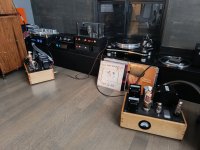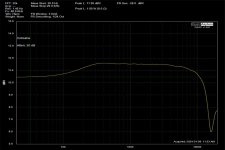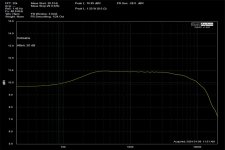i use the 1642 SE @110mA 1KVolts with GM70 direct coupled driven by 6BX7GT withc its driven by 126B IT / 6C45Pe, , very linear i take 4ohm output
fantastic sound and very powerful with little A2 in the last watts and symmetrical clipping
and also for my eimac 304TL @minimum 180mA 1260V and lineariti its excellent to 18Khz
so the problem its elsewere , maybe this very big transformer need more current to work
audiowize can you tell us more of high power SET amp with the 1642 you built? photo voltage current passing trough???
fantastic sound and very powerful with little A2 in the last watts and symmetrical clipping
and also for my eimac 304TL @minimum 180mA 1260V and lineariti its excellent to 18Khz
so the problem its elsewere , maybe this very big transformer need more current to work
audiowize can you tell us more of high power SET amp with the 1642 you built? photo voltage current passing trough???
Last edited:
The 304TL has a far lower driving impedance than 1.4K. Really these high frequency response issues are primarily going to be determined by the output stage and whether you have any feedback around the output transformer (which you definitely shouldn't with these!!!).
I'm running 810s at a little more than 800V/150mA.
I also posted a frequency response graph of a Monolith transformer soldered into the circuit temporarily to demonstrate how horrible this Hammond OT is.
I'm running 810s at a little more than 800V/150mA.
I also posted a frequency response graph of a Monolith transformer soldered into the circuit temporarily to demonstrate how horrible this Hammond OT is.
Attachments
i love 810! very nice amplifiers i love! beautyfull
.... choke /power transformer 90 ° implementation for less noise
for the 1642 i do not understand, please use 4 ohm output, black and green wire
also with GM70 the best linearity its with green wire
i do not use signal return feedback , but triode/IT/triode CF direct coupled to power triode
the 304TL SE get one more input CF triode direct coupled to 6C45Pe
.... choke /power transformer 90 ° implementation for less noise
for the 1642 i do not understand, please use 4 ohm output, black and green wire
also with GM70 the best linearity its with green wire
i do not use signal return feedback , but triode/IT/triode CF direct coupled to power triode
the 304TL SE get one more input CF triode direct coupled to 6C45Pe
I mean I'd use the 4 ohm outputs if I had 4 ohm speakers, but I'm more interested in having all the power available to 8 ohm speakers that I designed the amp for...
Unfortunately the Monoliths that I have won't fit on the chassis, so these might have to be replaced by the LL1688 running at 5.5K or one of the Laidys transformers from Asia.
I'm definitely disturbed that dztronic contacted Hammond about this issue 12 years ago and they were completely unaware of any problem when I contacted them.
Unfortunately the Monoliths that I have won't fit on the chassis, so these might have to be replaced by the LL1688 running at 5.5K or one of the Laidys transformers from Asia.
I'm definitely disturbed that dztronic contacted Hammond about this issue 12 years ago and they were completely unaware of any problem when I contacted them.
I would not get full power with an 8 ohm speaker on the 4 ohm tap. Yes, I would get slightly less THD since the load line will flatten out (at most frequencies at least), but I'll still only swing from B+ to where plate current and grid current are equal, and that just isn't going to move much between 5K and 10K.
I have a 1.4K source by using feedback between the 810 plate and my first stage. (and also by double checking my work with measurements)
I have a 1.4K source by using feedback between the 810 plate and my first stage. (and also by double checking my work with measurements)
No, it's understanding tube plate curves and the lower limit of what the output stage can deliver. 5K;4 is a 35:1 step-down. If I can swing all the way from 800V down to 0V (which I can't), then I can expect a maximum perfect world output of 33W. I am currently getting 49W. Based on the curves, I can realistically expect 27W of output in the regions where the transformer is able to appear as a 10K load since I can't pull the plate voltage under the grid voltage.
Last edited:
5000:8 is a 25:1 step-down.
5000:4 is a 35.3:1 step-down.
800V peak is 571V RMS. 571V RMS stepped down through a 35.3:1 transformer is 16.17V RMS. 16.17V RMS into an 8 ohm load is 32.68W.
800V peak is 571V RMS. 571V RMS stepped down through a 25:1 transformer is 22.84V RMS. 22.84V RMS into an 8 ohm load is 65.2W.
I have simplified this by ignoring that we can't swing all the way down to 0V. On the 8 ohm load/4 ohm tap configuration, we can swing down to about 75V. On the 8 ohm load/8 ohm tap, we can swing down to about 80V. Not a big difference here...
While the amp can swing up much, much higher with the 8 ohm load on the 4 ohm tap, that doesn't really matter based on the other side of the load line.
5000:4 is a 35.3:1 step-down.
800V peak is 571V RMS. 571V RMS stepped down through a 35.3:1 transformer is 16.17V RMS. 16.17V RMS into an 8 ohm load is 32.68W.
800V peak is 571V RMS. 571V RMS stepped down through a 25:1 transformer is 22.84V RMS. 22.84V RMS into an 8 ohm load is 65.2W.
I have simplified this by ignoring that we can't swing all the way down to 0V. On the 8 ohm load/4 ohm tap configuration, we can swing down to about 75V. On the 8 ohm load/8 ohm tap, we can swing down to about 80V. Not a big difference here...
While the amp can swing up much, much higher with the 8 ohm load on the 4 ohm tap, that doesn't really matter based on the other side of the load line.
Well if you have some really bright horn speakers or a really hard room, these would certainly tame down aggressive high frequency response; I certainly would not be happy with this kind of performance.
There are valid numerical reasons why a 304TL is going to put out more power through a 2.5K transformer rather than a 5K transformer, but these reasons do not apply to the amplifier that I have built. I've done my best to quantify this for you, and I don't know why you want me to waste my time bothering to measure this as well. When designing an amplifier, you should have a grasp on the optimal load impedance before construction, as you could get a waaaay better 2.5K output transformer than using a 5K:8 ratioed down.
There are valid numerical reasons why a 304TL is going to put out more power through a 2.5K transformer rather than a 5K transformer, but these reasons do not apply to the amplifier that I have built. I've done my best to quantify this for you, and I don't know why you want me to waste my time bothering to measure this as well. When designing an amplifier, you should have a grasp on the optimal load impedance before construction, as you could get a waaaay better 2.5K output transformer than using a 5K:8 ratioed down.
the GM70 SE also run on 4 ohm tap on 1642se , in a friend hi end high value installation, its the best amplifier he never have,
in the end a tube amplifier should make music
still you build very nice monobloc, so connect your speackers on 4 ohm and enjoy music
forget analyser oscilloscope etc just loose few db thats all
good night and music
claudio
in the end a tube amplifier should make music
still you build very nice monobloc, so connect your speackers on 4 ohm and enjoy music
forget analyser oscilloscope etc just loose few db thats all
good night and music
claudio
A pair of 1642s will appear in an upcoming project, probably mid-year, dedicated to below 350Hz, but we'll measure the full range response and post on DIYaudio. Still undecided whether 304TLs or parallel 211/VT-4-C, each with filaments in opposite polarity, AC, with a hum trim pot. Hopefully! - Rod Coleman regulators for type 304TLs are not trivial - 5 volts at 25 amps each - Yikes. If we have to go to DC for either noise or distortion reasons we will, but.
We expect to idle at between 125 and 150 mA, but can double that for OPT testing. Filament heating considerations shouldn't effect OPT measurements too much, I'd hope. But will post anything interesting.
All good fortune,
Chris
We expect to idle at between 125 and 150 mA, but can double that for OPT testing. Filament heating considerations shouldn't effect OPT measurements too much, I'd hope. But will post anything interesting.
All good fortune,
Chris
to heath 304TL i use one meanwell RSP 200-5 each tube no hum perfect silent . the making of my amp:
https://drive.google.com/drive/folders/1uljbdQQB9muXnGnpQloehz15iZemLoEp?usp=sharing
https://drive.google.com/drive/folders/1-FLurNv_Yo-zECWcanuGGk8qbq7T39PN?usp=sharing
https://drive.google.com/drive/folders/1uljbdQQB9muXnGnpQloehz15iZemLoEp?usp=sharing
https://drive.google.com/drive/folders/1-FLurNv_Yo-zECWcanuGGk8qbq7T39PN?usp=sharing
One would hope not, Hammond supplied industry standard broadcast line and mic transformers for generations.driving it directly with their audio analyzer that has a selectable 25 or 600 ohm output
My pair of discontinued and flawed 1628SE show a ~4 dB drop at 20 kHz on the 4 ohm secondary loaded with 8 ohms when driven UL. Recent open loop measurements attached. Feedback isn't a panacea. The transformer's reduced HF gain means reduced feedback and increased drive requirements. The cost gets moved upstream.
Attachments
- Home
- Amplifiers
- Tubes / Valves
- Anyone tried the Hammond 1642SE in a BIG SE amp?


